child restraint CHEVROLET S10 1995 2.G Owners Manual
[x] Cancel search | Manufacturer: CHEVROLET, Model Year: 1995, Model line: S10, Model: CHEVROLET S10 1995 2.GPages: 354, PDF Size: 18.92 MB
Page 19 of 354

Downloaded from www.Manualslib.com manuals search engine 0: Why don’t they just put in air bags so people won ’t have to wear
safety belts?
A: Air bags are in many vehicles today and will be in more of them in the
future. But they are supplemental systems only;
so they work with
safety belts - not instead of them. Every air bag system ever offered
for sale has required the
use of safety belts. Even if you’re in a vehicle
that has air bags,
you still have to buckle up to get the most protection.
That’s true
not only in frontal collisions, but especially in side and
other collisions.
Q: If I’m a good driver, and I never drive far from home, why should I
A: You may be an excellent driver, but if you’re in an accident - even
wear safety belts?
one that isn’t your fault - you and your passengers can be hurt. Being
a good driver doesn’t protect you from things beyond your control,
such as bad drivers.
Most accidents occur within
25 miles (40 km) of home. And the
greatest number of serious injuries and deaths occur at speeds of less
than
40 mph (65 km/h).
Safety belts are for everyone.
How to Wear Safety Belts Properly
Adults
This part is only for people of adult size.
Be aware that there are special things to know about safety belts and
children. And there are different rules for smaller children and babies. If a
child will be riding in your vehicle, see the part
of this manual called
“Children.” Follow those rules for everyone’s protection.
First, you’ll want
to know which restraint systems your vehicle has.
We’ll start with the driver Position.
Driver Position
This part describes the driver’s restraint system.
Lap-Shoulder Belt
The driver has a lap-shoulder belt. Here’s how to wear it properly.
1. Close and lock the door.
1-10
Page 34 of 354

Downloaded from www.Manualslib.com manuals search engine a.
To make it shorter, pull the belt as shown until it is snug. Buckle and
position
it the same way as the lap part of the driver’s safety belt (see
“Driver Position” in the Index). Make sure the release button on the buckle
is positioned
so you would be able to unbuckle the safety belt quickly if you
ever had to. To unlatch the belt, just push the button on the buckle.
Don’t use child restraints on these seats. They won’t work properly.
Children
Everyone in a vehicle needs protection! That includes infants and all
children smaller than adult size. In fact, the law in every state in the United
States and in every Canadian province says children up to some age must be
restrained while in a vehicle.
Smaller Children and Babies
1-25
Page 36 of 354
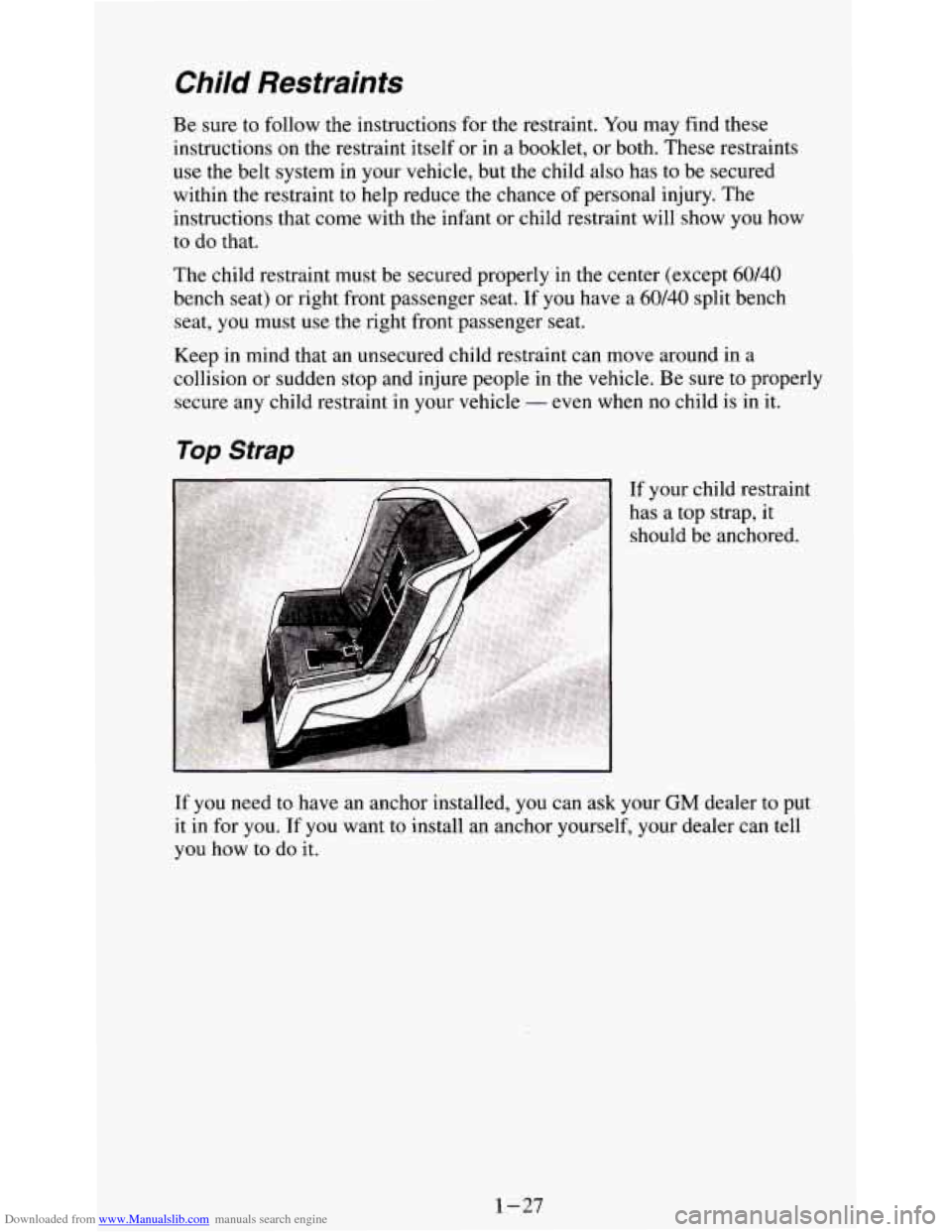
Downloaded from www.Manualslib.com manuals search engine Child Restraints
Be sure to follow the instructions for the restraint. You may find these
instructions on the restraint itself or in a booklet,
or both. These restraints
use the belt system in your vehicle, but the child also has to be secured
within the restraint to help reduce the chance
of personal injury. The
instructions that come with the infant or child restraint will show you how
to do that.
The child restraint must be secured properly
in the center (except 60/40
bench seat) or right front passenger seat. If you have a 60/40 split bench
seat, you must
use the right front passenger seat.
Keep
in mind that an unsecured child restraint can move around in a
collision or sudden stop and injure people in the vehicle. Be sure to properly
secure any child restraint in your vehicle
- even when no child is in it.
Top Strap
If your child restraint
has a top strap, it should be anchored.
If you need to have an anchor installed, you can ask your GM dealer to put
it in for you. If you want to install an anchor yourself, your dealer can tell
you how to do it.
1-27
Page 37 of 354
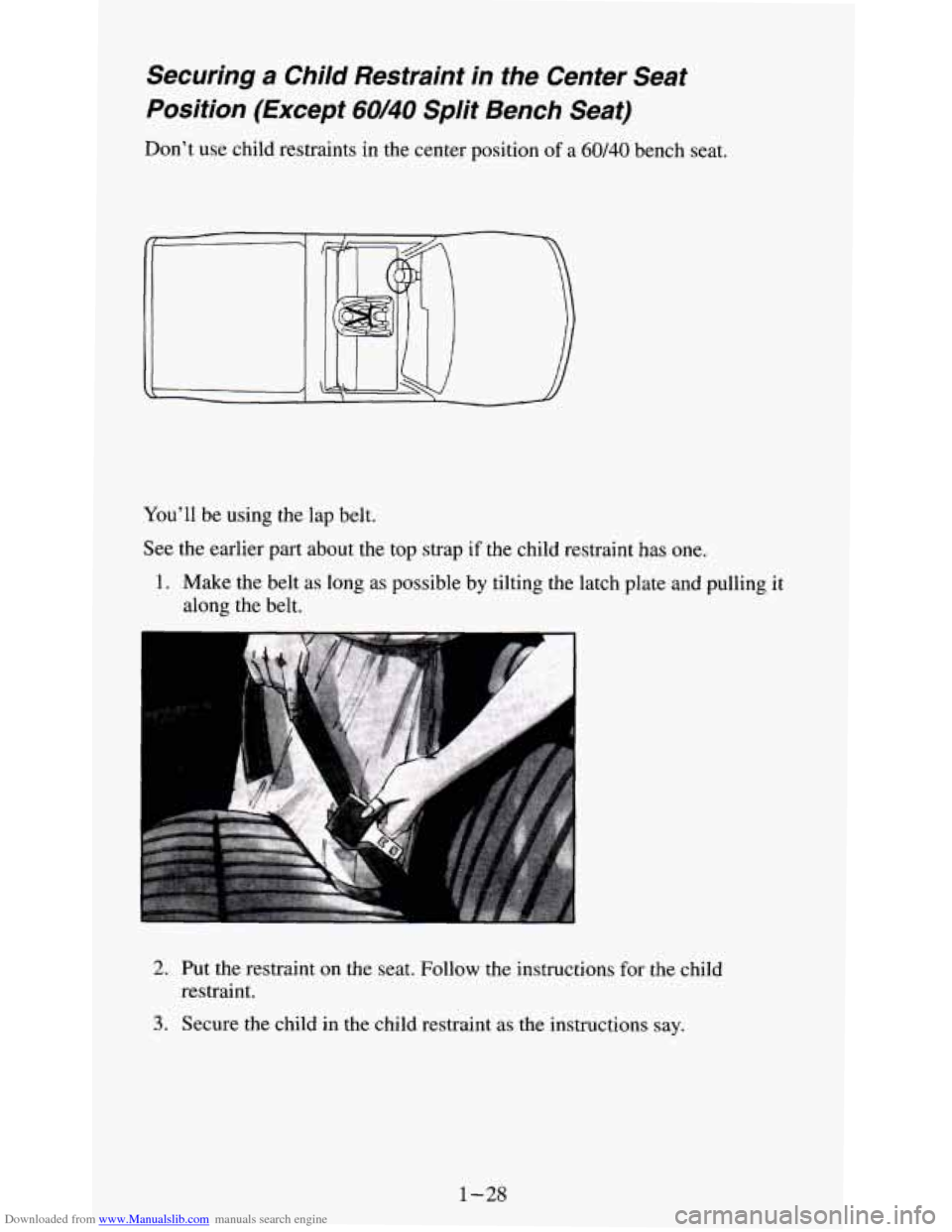
Downloaded from www.Manualslib.com manuals search engine Securing a Child Restraint in the Center Seat
Position (Except
60/40 Split Bench Seat)
Don’t use child restraints in the center position of a 60/40 bench seat.
You’ll be using the lap belt.
See the earlier part about the top strap if the child restraint has
one.
1. Make the belt as long as possible by tilting the latch plate and pulling it
along the belt.
2. Put the restraint on the seat. Follow the instructions for the child
restraint.
3. Secure the child in the child restraint as the instructions say.
1-28
Page 38 of 354
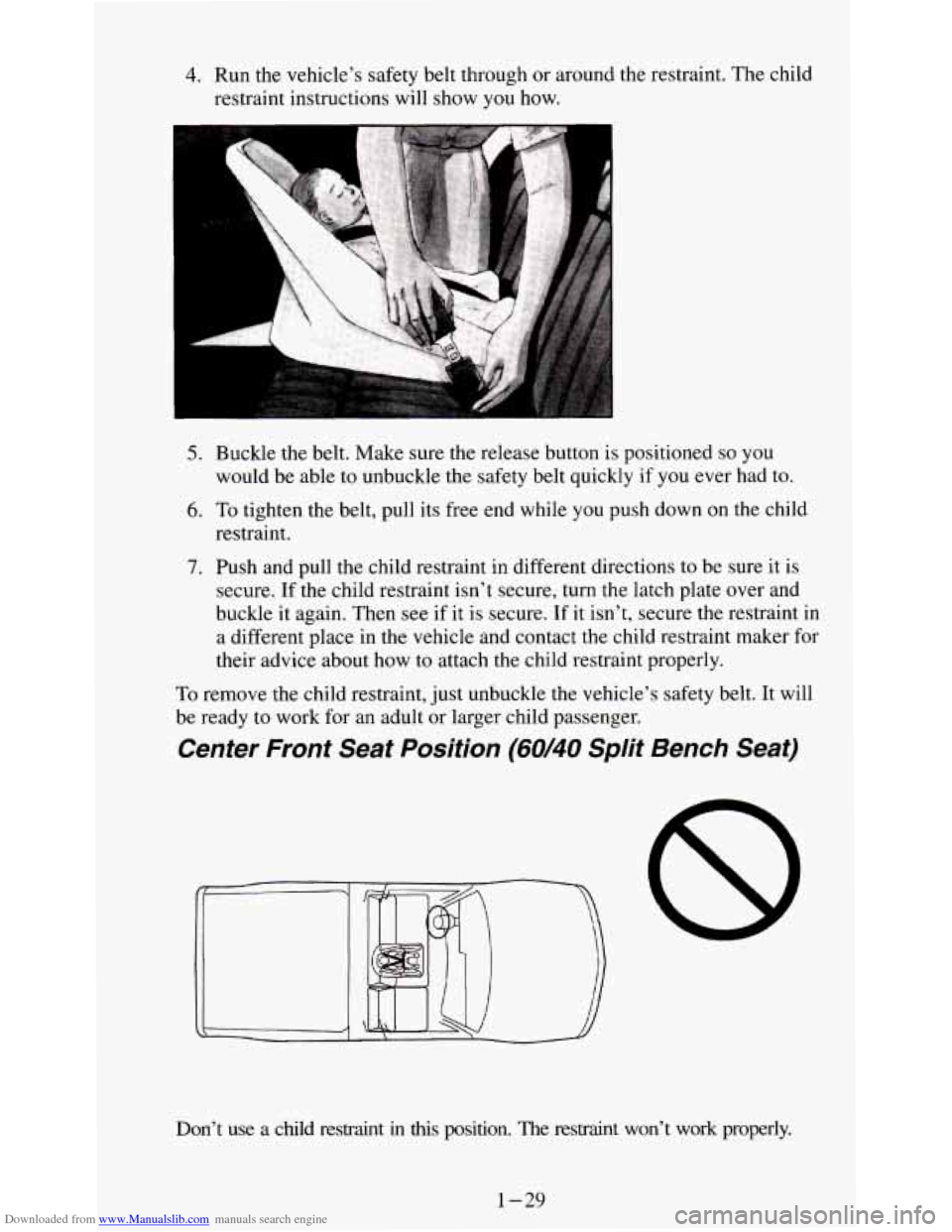
Downloaded from www.Manualslib.com manuals search engine 4. Run the vehicle’s safety belt through or around the restraint. The child
restraint instructions will show
you how.
5. Buckle the belt. Make sure the release button is positioned so you
would be able to unbuckle the safety belt quickly if you ever had to.
6. To tighten the belt, pull its free end while you push down on the child
restraint.
7. Push and pull the child restraint in different directions to be sure it is
secure. If the child restraint isn’t secure, turn the latch plate over and
buckle it again. Then
see if it is secure. If it isn’t, secure the restraint in
a different place in the vehicle and contact the child restraint maker for
their advice about how to attach the child restraint properly.
To remove the child restraint, just unbuckle the vehicle’s safety belt. It will
be ready to work for an adult or larger child passenger.
Center Front Seat Position (60/40 Split Bench Seat)
Don’t use a child restraint in this position. The restraint won’t work properly.
1-29
Page 39 of 354

Downloaded from www.Manualslib.com manuals search engine Jump Seats (Extended Cab)
Don’t use child restraints in these positions. The restraints won’t work
properly.
Securing a Child Restraint in the Right Front Seat
Position
You’ll be using the lap-shoulder belt. See the earlier part about the top strap
if the child restraint has
one.
1. Put the restraint on the seat. Follow the instructions for the child
restraint.
2. Secure the child in the child restraint as the instructions say.
1-30
Page 40 of 354
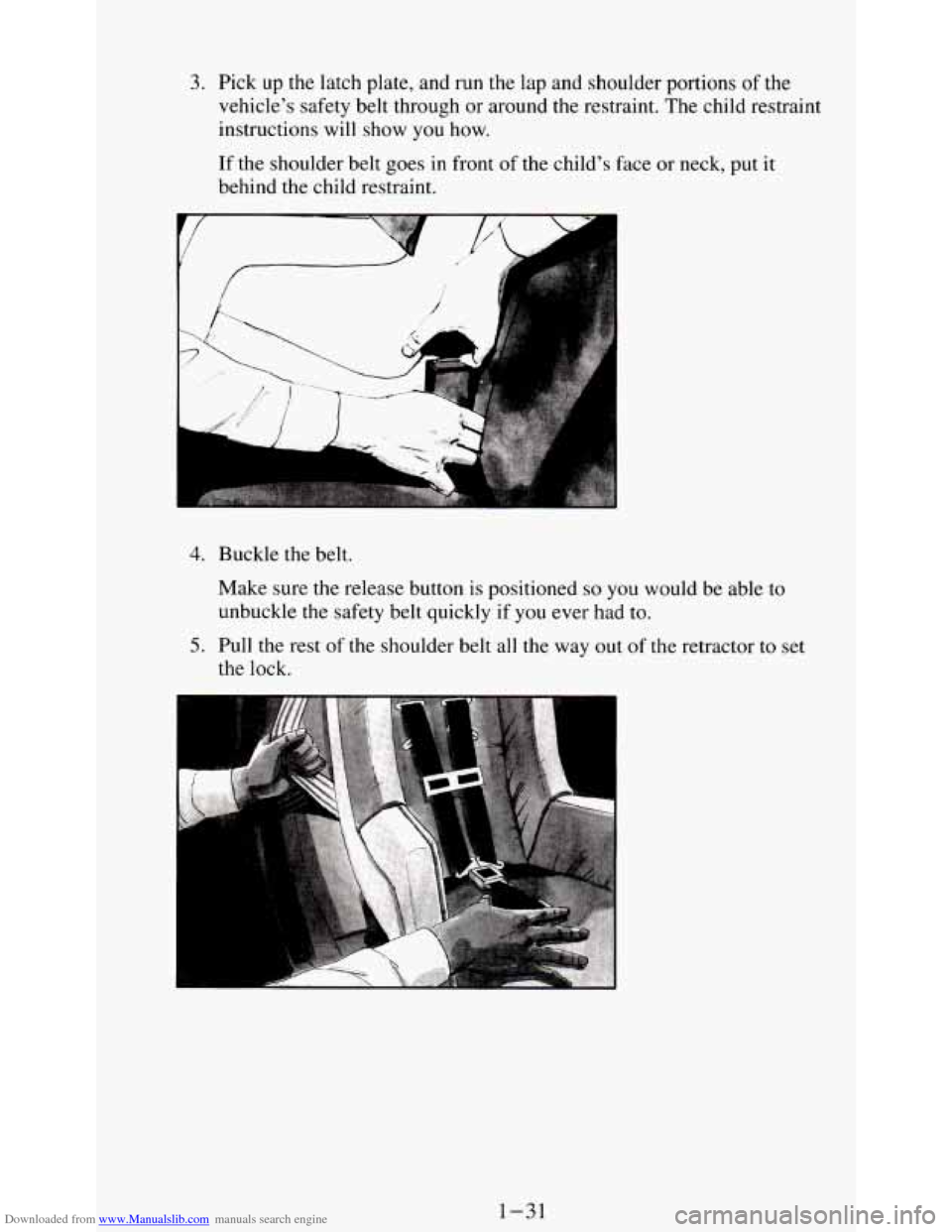
Downloaded from www.Manualslib.com manuals search engine 3. Pick up the latch plate, and run the lap and shoulder portions of the
vehicle’s safety belt through or around the restraint. The child restraint
instructions will show
you how.
If the shoulder belt goes in front of the child’s face or neck, put it
behind the child restraint.
4. Buckle the belt.
Make sure the release button is positioned
so you would be able to
unbuckle the safety belt quickly if
you ever had to.
5. Pull the rest of the shoulder belt all the way out of the retractor to set
the lock.
1-31
Page 41 of 354

Downloaded from www.Manualslib.com manuals search engine 6. To tighten the belt, feed the shoulder belt back into the retractor while
7. Push and pull the child restraint in different directions to be sure it is
To remove the child restraint, just unbuckle the vehicle's safety belt and let
it go back all the way.
The safety belt will move freely again and be ready to work for
an adult or
larger child passenger.
you
push down on the child restraint.
secure.
Larger Children
Children who have outgrown child restraints should wear the vehicle's
safety belts.
Page 42 of 354
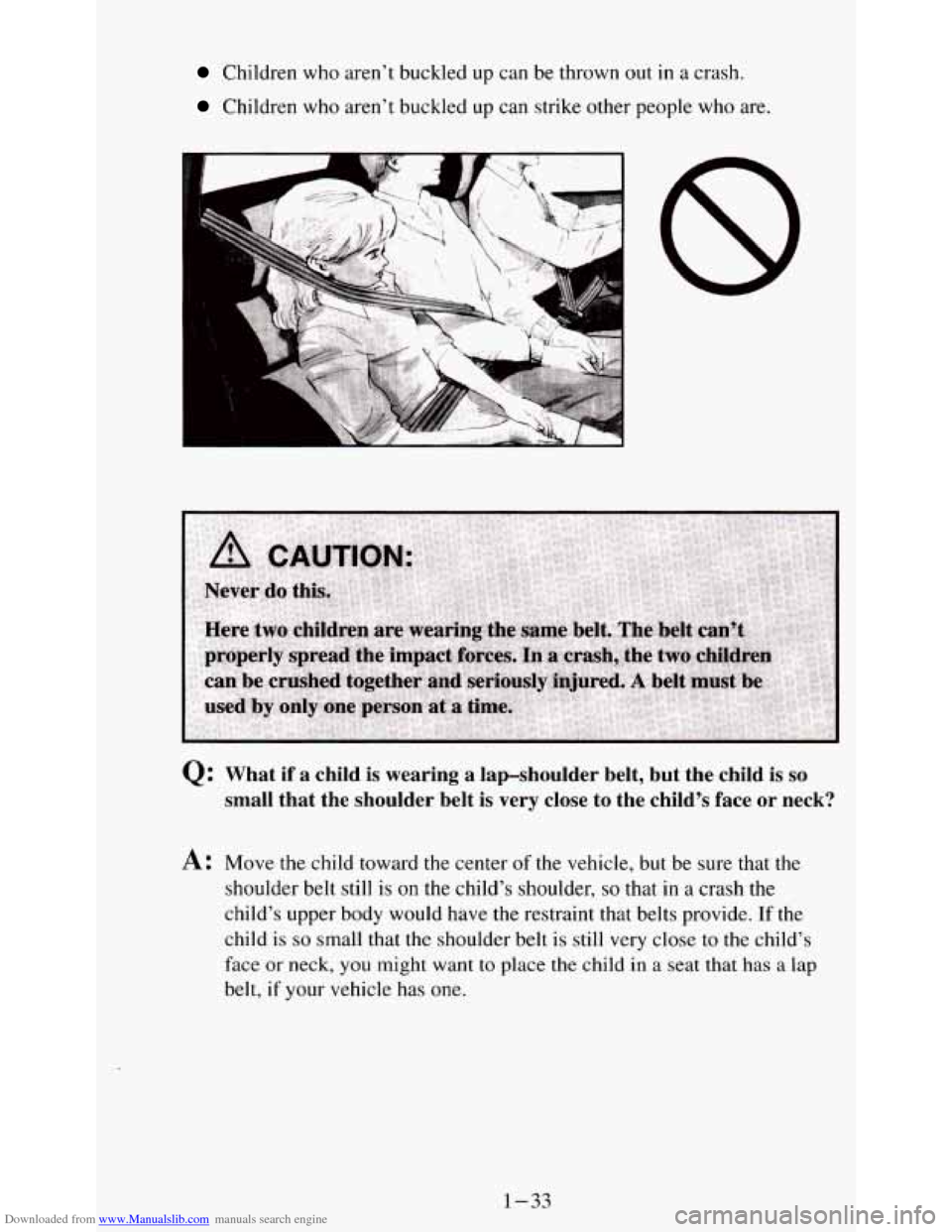
Downloaded from www.Manualslib.com manuals search engine Children who aren’t buckled up can be throWfl Out in a crasn.
Children who aren’t buckled up can strike other people who are.
Q: What if a child is wearing a lap-shoulder belt, but the child is so
small that the shoulder belt is very close to the child’s face or neck?
A: Move the child toward the center of the vehicle, but be sure that the
shoulder belt still is
on the child’s shoulder, so that in a crash the
child’s upper body would have the restraint that belts provide.
If the
child
is so small that the shoulder belt is still very close to the child’s
face
or neck, you might want to place the child in a seat that has a lap
belt, if your vehicle has
one.
1-33
Page 345 of 354
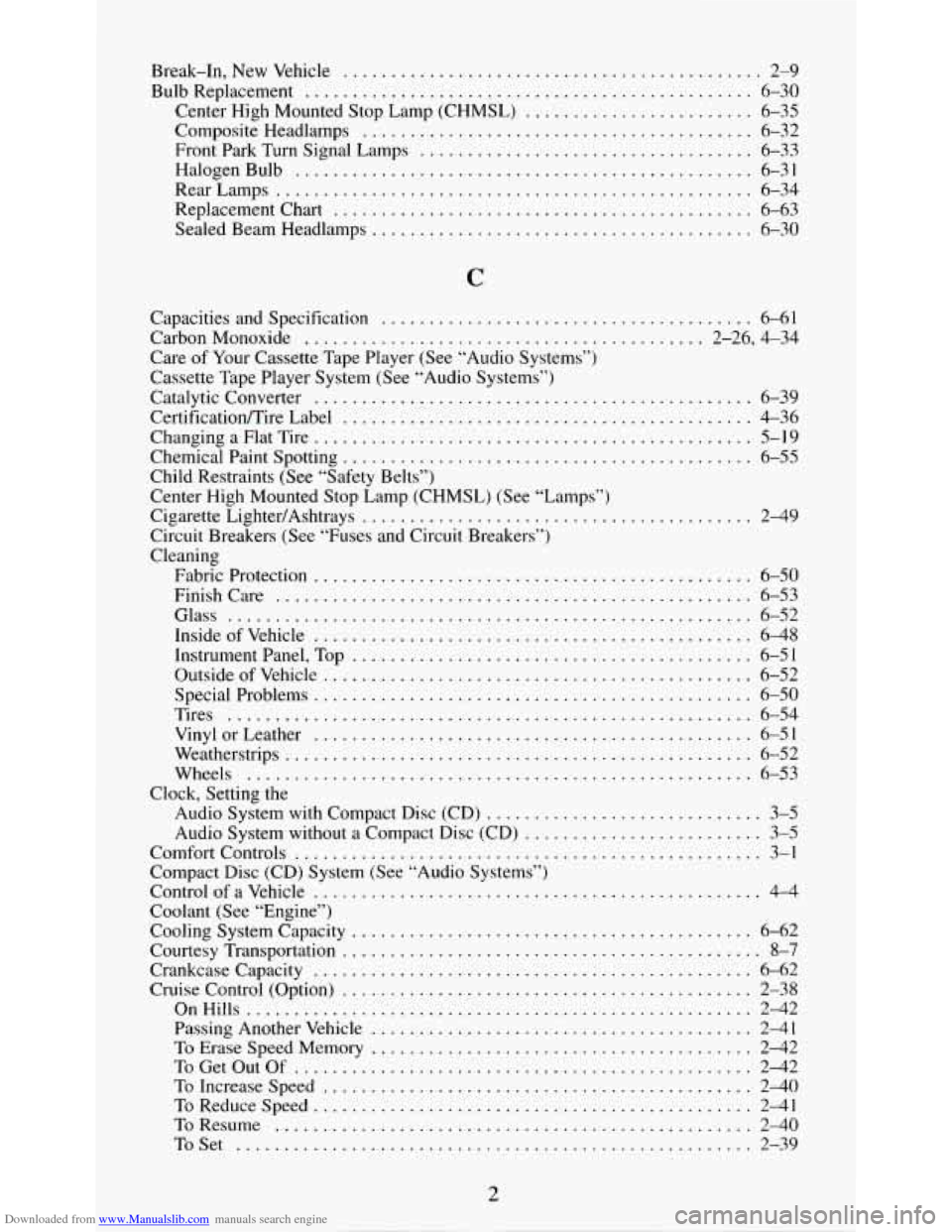
Downloaded from www.Manualslib.com manuals search engine Break.1n. New Vehicle ............................................ 2-9
Bulb Replacement
............................................... 6-30
Composite Headlamps
......................................... 6-32
Halogen Bulb
................................................ 6-31
Replacement Chart ............................................ 6-63
Sealed Beam Headlamps
........................................ 6-30
Center
High Mounted Stop Lamp (CHMSL)
........................ 6-35
Front Park Turn Signal Lamps
................................... 6-33
RearLamps .................................................. 6-34
Capacities and Specification
............ ....................... 6-61
CarbonMonoxide
.......................................... 2-26, 4-34
Care of Your Cassette Tape Player (See “Audio Systems”)
Cassette Tape Player System (See “Audio Systems”)
Catalytic Converter
.............................................. 6-39
CertificatiodTire Label
........................................... 4-36
Changing
a Flat Tire .............................................. 5-19
Chemical Paint Spotting
........................................... 6-55
Cigarette LightedAshtrays
......................................... 2-49
Child
Restraints (See “Safety Belts”)
Center High Mounted Stop Lamp (CHMSL) (See “Lamps“)
Circuit Breakers (See “Fuses and Circuit Breakers”)
Cleaning Fabric Protection
.............................................. 6-50
Finishcare
.................................................. 6-53
Glass ....................................................... 6-52
InsideofVehicle
.............................................. 6-48
Instrumentpanel, Top .......................................... 6-51
Outsideofvehicle
............................................. 6-52
Tires
....................................................... 6-54
VinylorLeather
.............................................. 6-51
Wheels
........................................ ........ 6-53
Special
Problems
.............................................. 6-50
Weatherstrips ................................................. 6-52
Audio System with Compact Disc (CD)
............................. 3-5
Clock, Setting
the
Audio System without
a Compact Disc (CD) ......................... 3-5
Comfort Controls
................................................. 3-1
Compact Disc (CD) System (See “Audio Systems”)
Control
of a Vehicle ........................................... 4-4
Coolant (See “Engine”)
Cooling System Capacity
.......................................... 6-62
Courtesy Transportation
............................................ 8-7
Crankcase Capacity .............................................. 6-62
Cruise Control (Option)
........................................... 2-38
Passing Another Vehicle
........................................ 2-41
To Erase Speed Memory
........................................ 2-42
To Increase Speed
............................................. 2-40
OnHills
..................................................... 2-42
ToGetOutOf
................................................ 2-42
ToReduceSpeed
.............................................. 2-41
ToResume .................................................. 2-40
ToSet ...................................................... 2-39
2